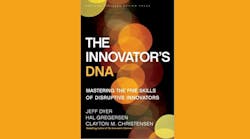If good managers hire people who are smarter than they are, does that make the CEO the dumbest person in the company?
While that question -- posed in a "Dilbert" cartoon -- might seem flip and irreverent, Brigham Young University professor Jeff Dyer uses it as an example of one of the four behaviors that form the secret sauce of being an innovator.
"The innovation challenge is about asking questions that challenge the status quo, because you're trying to change what is in the world," Dyer said during his keynote at the 2012 Front End of Innovation conference in Orlando, Fla.
Being innovative can be taught, Dyer asserted. He pointed to research suggesting that while general intelligence is mostly based on genetics, creativity is more the product of nurture than nature.
"There are a variety of things that shape your ability to be a creative thinker, and one of the really important things is whether or not you are encouraged to question," Dyer said.
'More Creative Capacity than You Might Think'
Even if you haven't been encouraged to be inquisitive in your professional or personal life, Dyer insisted that "you have more creative capacity than you think, and you can get better at it."
With that premise in mind, Dyer, Hal Gregersen and Clayton Christensen co-authored "The Innovator's DNA: Mastering the Five Skills of Disruptive Innovators." For the book, the trio interviewed nearly 100 inventors and innovators to learn their techniques for coming up with creative business ideas.
"We were really interested in understanding how does someone like Steve Jobs 'think different,'" Dyer said, referring to the late-1990s Apple ad campaign.
The trio concluded that "associational thinking" -- also known as "right-brain thinking," "lateral thinking" or "creative thinking" -- is a building block of the innovator's DNA. Dyer described associational thinking as "the ability to connect seemingly unrelated ideas and put them together in new ways."
From their eight-year study, Dyer, Gregersen and Clayton identified four behaviors that trigger associational thinking: questioning, observing, experimenting and networking.
Questioning
Often, asking questions that challenge conventional wisdom is "the critical first step to innovative thinking," according to Dyer.
The co-authors also learned that the best questions often are the ones "that impose constraints on your thinking." Dyer offered this example: "What if we were legally prohibited from conducting any future business with our [current] set of customers? How would we make money next year?"
That kind of question, Dyer added, challenges the business-as-usual mentality.
"It requires a deeper fundamental questioning of, 'What are we good at? What are our competencies? What else could we create? Who else could we take it to?"
Observing
Observing, according to the co-authors of "The Innovator's DNA," means "scrutinizing the behavior of customers, suppliers and competitors to identify new ways of doing things."
Interestingly, their research showed that by living in two or more countries, or working in two or more businesses and functions, you're twice as likely to be an innovator, Dyer noted.
"Spending that time in the different environments makes a big difference," Dyer said.
Procter & Gamble Co. (IW 500/10) understands this. The Cincinnati-based maker of Tide detergent, Bounty paper towels and Duracell batteries swaps employees with other companies to expose them to different ways of doing things, Dyer said.
During one such swap with Google, Dyer explained, Procter & Gamble was in the midst of a product launch. Google's visiting marketing employees were "aghast" that P&G hadn't invited any "mommy bloggers" to a media event for the new product.
"So [P&G] learned about bloggers and the importance of trying to connect to bloggers as a way to market their product," Dyer said. "And [P&G] said a few weeks later that they held another event that was just for the mommy bloggers to help educate them and to help them launch their product."
Experimenting
Experimenting, according to the co-authors of "The Innovator's DNA," means "constructing interactive experiences and provoking unorthodox responses to see what insights emerge."
Dyer noted that experimenting is more than just testing an idea to see if it works -- it's also about indulging your curiosity.
He pointed to the late Steve Jobs, who said that the things that he learned in a calligraphy class at Reed College in Portland, Ore., actually influenced the typography of the first Macintosh computer.
"Experimenting is testing ideas and testing your hypotheses, but it's also just seeking out new experience, trying new things, learning new things and taking things apart," Dyer said.
Networking
Networking is meeting people with different ideas and perspectives, in the hopes of finding, refining and testing new ideas, Dyer explained.
"One way to think outside the box -- to use the phrase that we've often heard -- is to talk to somebody who plays in a different box and see if somehow you can connect your ideas together," he said. "You're actively seeking diverse ideas, and that's what's really important.
"You can't just talk to people who think like you."
Dyer credits salesforce.com founder Marc Benioff for going out of his way to network with young entrepreneurs such as Dropbox founder Drew Houston, who is nearly 20 years his junior. Benioff has said that such interaction inspired new products like Chatter, an enterprise social network developed by salesforce.com.
"The more you can reach out to folks with different and diverse backgrounds, the more likely they are going to see something that you haven't seen and help you to see a problem in a different way," Dyer noted.
The four behaviors listed above, Dyer concluded, "will turbocharge your creative thinking."
See Also:



